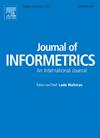Collaboration networks and radical innovation: Two faces of tie strength and structural holes
IF 3.5
2区 管理学
Q2 COMPUTER SCIENCE, INTERDISCIPLINARY APPLICATIONS
引用次数: 0
Abstract
This paper studies how tie strength and structural holes collectively affect innovation radicalness at a location within an innovating firm. We identified 16,011 inventors’ locations of the 93 most innovative U.S. pharmaceuticals and biotechnology companies on the EU Industrial R&D Investment Scoreboard. We tracked their patents from 2001 to 2013 and constructed a panel dataset for analysis. Using firm-location fixed effect models, we found that the average tie strength of a location's egocentric network has a negative effect on innovation radicalness, and this negative effect is stronger when the location's egocentric network is cohesive. This suggests that weak ties have informational advantages for radical innovation, which are more pronounced when there is network cohesion to mitigate the relational disadvantages of weak ties. We also found a negative effect of structural holes on innovation radicalness when tie strength is weak but a positive effect when tie strength is strong. This indicates that strong ties are needed for mobilizing the informational advantages associated with structural holes.
协作网络与激进创新:纽带强度与结构孔的两面
本文研究了在创新企业内部某一地点,纽带强度和结构孔如何共同影响创新激进性。我们确定了欧盟工业研发投资记分牌上93家最具创新性的美国制药和生物技术公司的16,011个发明人所在地。我们从2001年到2013年追踪了他们的专利,并构建了面板数据集进行分析。利用企业-区位固定效应模型,我们发现,区位自我中心网络的平均联结强度对创新激进度有负向影响,且当区位自我中心网络具有内聚性时,这种负向影响更强。这表明弱联系对突破性创新具有信息优势,当存在网络内聚来缓解弱联系的关系劣势时,这种优势更为明显。研究还发现,当联系强度较弱时,结构孔对创新激进性的影响为负,而当联系强度较强时,结构孔对创新激进性的影响为正。这表明需要强有力的联系来调动与结构漏洞有关的信息优势。
本文章由计算机程序翻译,如有差异,请以英文原文为准。
求助全文
约1分钟内获得全文
求助全文
来源期刊

Journal of Informetrics
Social Sciences-Library and Information Sciences
CiteScore
6.40
自引率
16.20%
发文量
95
期刊介绍:
Journal of Informetrics (JOI) publishes rigorous high-quality research on quantitative aspects of information science. The main focus of the journal is on topics in bibliometrics, scientometrics, webometrics, patentometrics, altmetrics and research evaluation. Contributions studying informetric problems using methods from other quantitative fields, such as mathematics, statistics, computer science, economics and econometrics, and network science, are especially encouraged. JOI publishes both theoretical and empirical work. In general, case studies, for instance a bibliometric analysis focusing on a specific research field or a specific country, are not considered suitable for publication in JOI, unless they contain innovative methodological elements.
 求助内容:
求助内容: 应助结果提醒方式:
应助结果提醒方式:


